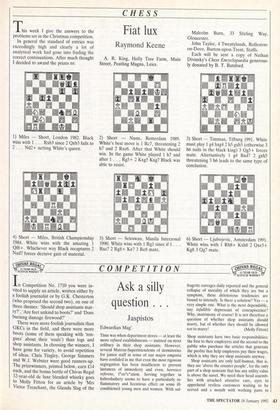CHESS
Fiat lux
Raymond Keene
This week I give the answers to the problems set in the Christmas competition.
In general the standard of entries was exceedingly high and clearly a lot of analytical work had gone into finding the correct continuations. After much thought I decided to award the prizes to: A. R. King, Holly Tree Farm, Main Street, Peatling Magna, Leics. Malcolm Burn, 33 Stirling Way, Gloucester.
John Taylor, 4 Twentylands, Rolleston- on-Dove, Burton-upon-Trent, Staffs.
Each will be sent a copy of Nathan Divinsky's Chess Encyclopaedia generous- ly donated by B. T. Batsford.
1) Miles — Short, London 1982. Black wins with 1 . . . Rxb3 since 2 Qxb3 fails to 2 . . . Nd2+ netting White's queen. 2) Short — Nunn, Rotterdam 1989. White's best move is 1 Rc7, threatening 2 h7 and 2 Rxc6. After that White should win. In the game White played 1 h7 and after 1 . . . Rg5+ 2 Kxg5 Kxg7 Black was able to resist. 3) Short — Timman, Tilburg 1991. White must play 1 g4 hxg4 2 h5 gxh5 (otherwise 3 h6 nails in the black king) 3 Qg5+ forces mate. Alternatively 1 g4 Bxd7 2 gxh5 threatening 3 h6 leads to the same type of conclusion.
4) Short — Miles, British Championship 1984. White wins with the amazing 1 Qf8+. Whichever way Black recaptures 2 Nxd7 forces decisive gain of material. 5) Short — Seirawan, Manila Interzonal 1990. White wins with 1 Rgl since if 1 . . . Rxc7 2 Rg8+ Ke7 3 Re8 mate. 6) Short — Ljubojevic, Amsterdam 1991. White wins with 1 Rh8+ Kxh8 2 QxeS+ Kg8 3 Qg7 mate.


















































 Previous page
Previous page